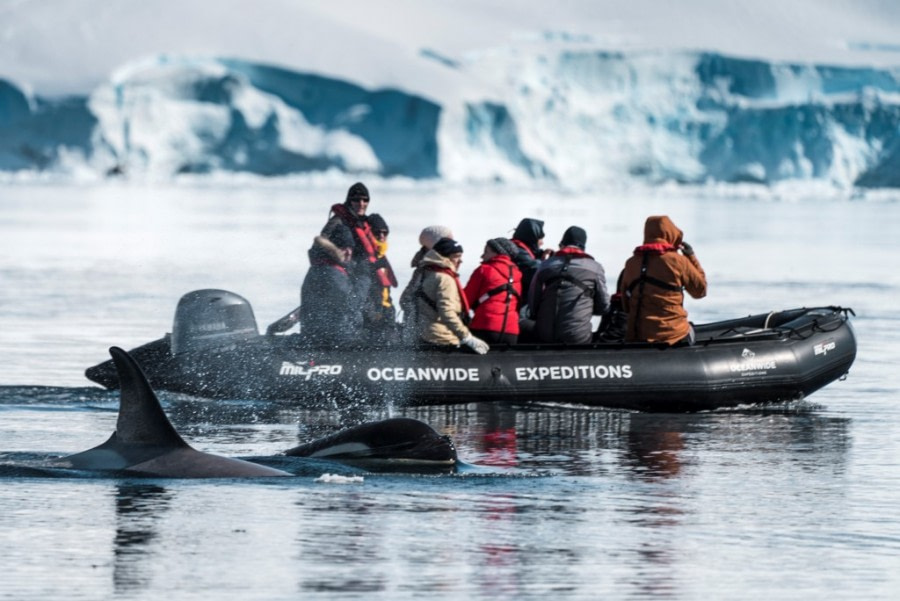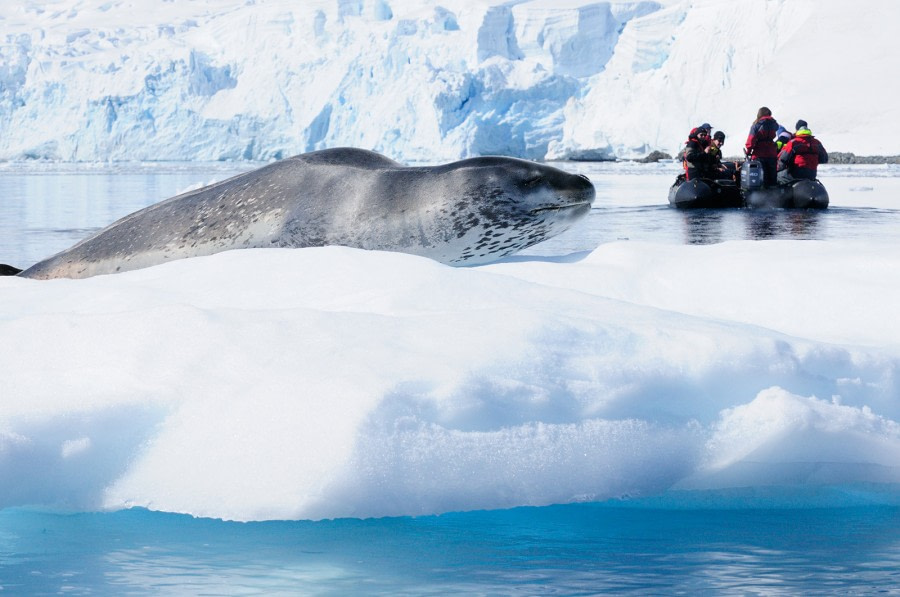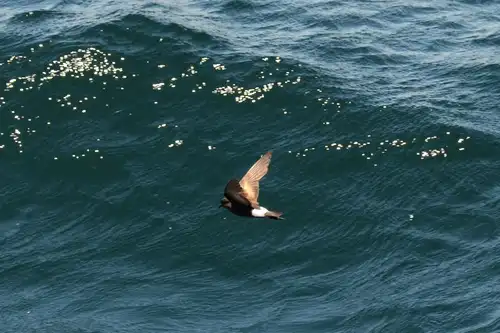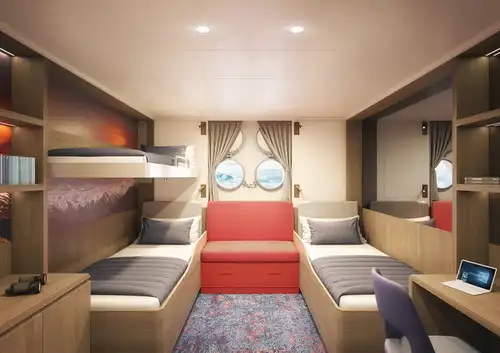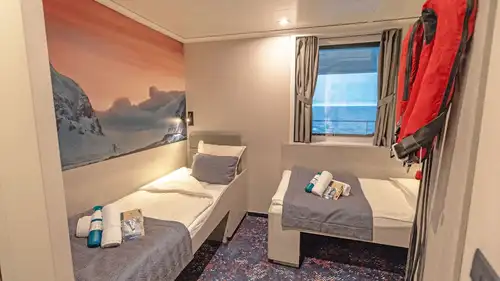

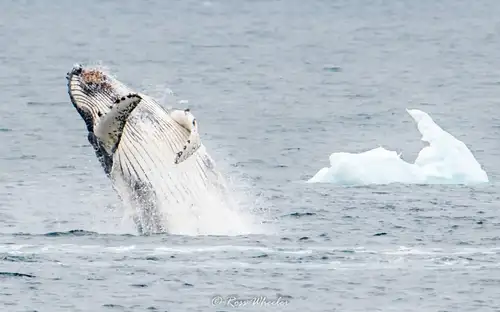
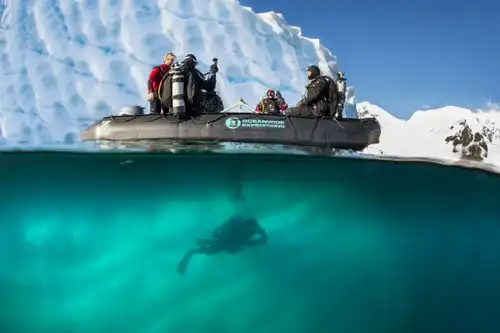












































 10 Days/9 Nights
10 Days/9 Nights




Note: All itineraries are for guidance only. Programs may vary depending on ice, weather, and wildlife conditions. Landings are subject to site availabilities, permissions, and environmental concerns per AECO regulations.
Your expedition begins where the world drops off. Ushuaia, Argentina, known as the southernmost city on the planet, is located on the far southern tip of South America. Starting in the afternoon, you set off from this small resort town on Tierra del Fuego, nicknamed “The End of the World,” and sail the mountain-fringed Beagle Channel for the remainder of the evening.
Path of the polar explorers
Over the next two days on the Drake Passage, you enjoy some of the same experiences encountered by the great polar explorers who first charted these regions: cool salt breezes, rolling seas, maybe even a fin whale spouting up sea spray. After passing the Antarctic Convergence – Antarctica’s natural boundary, formed when north-flowing cold waters collide with warmer sub-Antarctic seas – you are in the circum-Antarctic upwelling zone. Not only does the marine life change, the bird life changes too. Wandering albatrosses, grey-headed albatrosses, black-browed albatrosses, light-mantled sooty albatrosses, cape pigeons, southern fulmars, Wilson’s storm petrels, blue petrels, and Antarctic petrels are a few of the birds you might see.
Entering Antarctica
Gray stone peaks sketched with snow, towers of broken blue-white ice, and dramatically different wildlife below and above. You first pass the snow-capped Melchior Islands and Schollaert Channel, sailing between Brabant and Anvers Islands.
Sites you may visit include:
- Danco Island – Activities here may focus on the gentoo penguins nesting on the island, in addition to the Weddell and crabeater seals that can be found nearby.
- Neko Harbour – An epic landscape of mammoth glaciers and endless wind-carved snow, Neko Harbour offers opportunities for a Zodiac cruise and landing that afford the closest views of the surrounding alpine peaks.
- Paradise Bay – You may be able to take a Zodiac cruise in these sprawling, ice-flecked waters, where there’s a good chance you’ll encounter humpback and minke whales.
- Pléneau & Petermann Islands – If the ice allows it, you could sail through the Lemaire Channel in search of Adélie penguins and blue-eyed shags. There is also a possibility you’ll encounter humpback and minke whales here, as well as leopard seals.
- Port Lockroy – After sailing through the Neumayer Channel, you may get a chance to visit the former British research station – now a museum and post office – of Port Lockroy on Goudier Island. You may also be able to partake in activities around Jougla Point, meeting gentoo penguins and blue-eyed shags.
- Wilhelmina Bay & Guvernøren – This is a great place to spot humpback whales. You also may embark on a Zodiac cruise ending at the ghostly wreck of the Guvernøren, a whaling vessel that caught fire here in 1915. Around the Melchior Islands, amid a frozen landscape peopled with icebergs, you may encounter even more whales, leopard seals, and crabeater seals.
Conditions on the Drake Passage determine the exact time of departure.
Familiar seas, familiar friends
Your return cruise is far from lonely. While crossing the Drake, you’re again greeted by the vast array of seabirds remembered from the passage south. But they seem a little more familiar to you now, and you to them.
There and back again
Every adventure, no matter how grand, must eventually come to an end. It’s now time to disembark in Ushuaia, but with memories that will accompany you wherever your next adventure lies.





























































































m/v Hondius
Hondius is the world’s first-registered Polar Class 6 vessel and was built from the ground up for expedition cruising.

Specifications
| Passengers: | 170 in 80 cabins |
| Staff & crew: | Crew 57 | Guides 13 | Doctor 1 |
| Length: | 107.6 meters |
| Breadth: | 17.6 meters |
| Draft: | 5.30 meters |
| Ice class: | Polar Class 6 (equivalent 1A-Super) |
| Displacement: | 5,590 tonnes |
| Propulsion: | 2 x ABC main engines; total 4,200 kW |
| Speed: | 15 knots |
Cabins Gallery


Ship Interior Gallery


Ship Exterior Gallery


Hondius is the first-registered Polar Class 6 vessel in the world, meeting the latest and highest Lloyd’s Register standards for ice-strengthened cruise ships. Surpassing the requirements of the Polar Code adopted by the International Maritime Organization (IMO), Hondius represents the most flexible, advanced, innovative touring vessel in the polar regions, thoroughly optimized for exploratory voyages that provide you the utmost first-hand contact with the Arctic and Antarctica.
Happier polar passengers, healthier polar environment
Not only will the numerous amenities and on-board entertainments help make your Hondius voyage truly memorable, this ship also gives you the peace of mind that comes with choosing one of the most environmentally friendly vessel on the polar seas.
Hondius uses LED lighting, steam heating, bio-degradable paints and lubricants, and state-of-the-art power management systems that keep fuel consumption and CO2 levels minimal. This means that when you sail aboard Hondius, you get to enjoy the exotic landscapes and wildlife as much as possible while impacting them as little as possible.
Hotel comfort, expedition class
Please be aware that a small number of cabins may have a partially obstructed view due to the size of the windows and the design requirements of the ship. For example, some windows may be partly obstructed in the lower half by a gangway.
The best view is always on the outer deck or the bridge. Hondius offers high-quality accommodation for 170 passengers in six grand suites with balconies (27 square meters, 291 square feet), eight junior suites (19 to 20 square meters, 205 to 215 square feet), eight superior cabins (20 to 21 square meters, 215 to 226 square feet), 11 twin deluxe cabins, (19 to 21 square meters, 205 to 226 square feet), 14 twin window cabins (12 to 14 square meters, 129 to 151 square feet) as well as 27 twin porthole cabins, two triple porthole cabins, and four quadruple porthole cabins that vary in size from 12 to 18 square meters, or 129 to 194 square feet.
One deck consists of a large observation lounge and a separate lecture room, which are reserved for a wide variety of interactive workshops, exhibitions, and performances particular to Hondius.
Swift & safe ship-to-shore operations
It is our philosophy to keep sea time short so that we can focus instead on fast, effective access to shore and near-shore activities. To give you the maximum contact with the nature and wildlife you traveled so far to see, we employ a tough fleet of rigid-hull inflatable Zodiac boats that guarantee swift and safe landing operations for the passengers. Hondius has two separate gangways and a sheltered indoor Zodiac boarding area that can also be used for special outdoor activities, such as kayaking.
Age and nationality
Passengers on a typical voyage range from in their 30s to their 80s, with the majority usually between 45 ― 65. Our expeditions attract independent travelers from around the globe who are characterized by a strong interest in exploring remote regions. The camaraderie that develops on board is an important part of the Oceanwide experience, and many passenger groups include several nationalities.
What to wear
In keeping with the spirit of the expedition, dress on board is informal. Bring casual and comfortable clothing for all activities, and keep in mind that much of the scenery can be appreciated from the deck ― which can be slippery. Bring sturdy shoes with no-slip soles, and make sure your parka is never far away in case one of our crew shouts “Whales!” over the loudspeaker and you have to dash outside at a moment’s notice. Opt for layers, as it is comfortably warm aboard the ship though often cold on deck.
How to pay
Refreshments and souvenirs will be charged to your cabin. The day before departure you can settle your bill with the hotel manager, paying by credit card (Visa or MasterCard) or cash (euro, or in some cases dollar). We cannot, however, accept checks. Though the prices and standard currency on board is in the euro, other currencies may be accepted at the discretion of the hotel manager, at prevailing rates.
Electric current
The electrical supply aboard ship is 220v, 60Hz. Electrical outlets are standard European with two thick round pins, so some passengers may need a 220v/110v converter.
Gratuities
The customary gratuity to the ship’s service personnel is made as a blanket contribution at the end of the voyage and is divided among the crew. Tipping is a personal matter, and the amount you wish to give is at your sole discretion. As a generally accepted guideline, we suggest 8 ― 10 euros per passenger per day. It is better for the crew if you give cash.
Non-smoking policy
We have a non-smoking policy inside all our vessels, though you can smoke in certain designated areas. We ask that you please respect the wishes of non-smokers.
Your physical condition
You must be in good overall health and be able to walk several hours per day. The expedition is ship-based and physically not very demanding, but we spend as much time as possible on shore. You are, however, welcome to remain aboard the ship if you prefer. To join most excursions you must be able to get up and down the steep gangway ― from the ship to the water level ― to board the Zodiacs. Staff will assist you in and out of the boats, and boarding will become progressively easier with practice, but conditions on shore can be slippery and rocky. Remember, you will be traveling in remote areas without access to sophisticated medical facilities, so you must not join this expedition if you have a life-threatening condition or need daily medical treatment.

The average price for flights (round trip) to Ushuaia
From Jakarta: $2,300
From Singapore: $2,500
From Kuala Lumpur: $1,900
Insurance Requirements:
- Mandatory Insurance: All travelers must have insurance covering medical expenses, accidents, and repatriation/evacuation.
- Recommended Insurance: It is strongly recommended to include cancellation insurance for added protection.
Drone Usage Policy:
- Prohibited: The use of drones is strictly prohibited during the expedition.
Clothing and Gear Recommendations:
- Water-Resistant Coat and Pants: Essential for protection against the wet and windy conditions.
- Layered Underwear: To ensure warmth and comfort in extreme weather.
- Sunglasses: Necessary to protect against the strong UV rays and glare from the snow.
- Gloves: Insulated and water-resistant gloves to keep your hands warm and dry.
- Additional Items: Consider packing a warm hat, thermal socks, and sturdy waterproof boots.
- Voyage aboard the indicated vessel as indicated in the itinerary
- All meals throughout the voyage aboard the ship including snacks, coffee and tea.
- All shore excursions and activities throughout the voyage by Zodiac.
- Program of lectures by noted naturalists and leadership by experienced expedition staff.
- Free use of rubber boots and snowshoes.
- Pre-scheduled group transfer from the vessel to the airport in Ushuaia (directly after disembarkation).
- All miscellaneous service taxes and port charges throughout the programme.
- Comprehensive pre-departure material.
- Any airfare, whether on scheduled or charter flights
- Pre- and post- land arrangements.
- Passport and visa expenses.
- Government arrival and departure taxes.
- Meals ashore.
- Personal health Insurance for Medical, Accident and Repatriation/evacuating..
- Excess baggage charges and all items of a personal nature such as laundry, beverage charges and Internet charges.
- The customary gratuity at the end of the voyages for stewards and other service personnel aboard (guidelines will be provided).
- Yes, but the minimum age we can allow on board is three years old, however we advise against travelling with children under 8 years old. The maximum age we consider to be a child is 16 years old. We offer a 40% child discount in certain cabin types on a selection of voyages for children between three and 15 years old.
- That is hard to say. It depends on the weather and constraints of time and distance. Depending on the voyage, you may spend several days aboard the ship, followed by a series of landings, each several hours long. On some cruises, you land two or three times every day. During our time at the high latitudes, we will have almost continuous daylight, which means we may schedule excursions before breakfast, after dinner, or in the middle of the night. Often the light for photography is best at these times. We would like to show you as much as possible, but we also want to leave it up to you to skip an excursion.
- When you make a confirmed reservation, we require a 40% deposit. But if the reservation is made within two months prior to departure, the full price of the voyage is due at the time of booking.
- No, you are not able to change currency on board.
- Animal lovers who take their holiday in the Antarctic Peninsula will be treated to a diverse list of wildlife that is especially suited to the area's cold climate. It is common to encounter several penguin species such as the Gentoo penguins. Other types of wildlife that can be spotted from an Antarctic cruise or an Antarctic Peninsula land expedition include the Weddell seal, the Antarctic shag and Snow petrels.
- The Antarctic Peninsula follows Coordinated Universal Time -3 (UTC -3). This means that if it is 18:00 UTC-3 (6 p.m.) during your expedition cruise trip to the Antarctic Peninsula , it would be 17:00 (5 p.m.) in New York City, USA and 22:00 (10 p.m.) in London, U.K.
- The number of passengers is limited to 174 on the Hondius. Furthermore the vessel is manned by 24 highly experienced international nautical crew, 32-34 international hotel crew, 13 expedition staff (1 expedition leader, 2 assistant expedition leaders and 10 guides/lecturers) and 1 doctor.
- The Hondius was built in Croatia in 2018 and delivered in 2019.
You May Also Like



Antarctica - Basecamp - free camping, kayaking, snowshoe/hiking, mountaineering, photo workshop
 13 Days / 12 Nights
13 Days / 12 Nights

Falkland Islands - South Georgia - Antarctica
 19 Days / 18 Nights
19 Days / 18 Nights

Antarctica - Discovery and learning voyage + navigational workshop
 11 Days / 10 Nights
11 Days / 10 Nights

Antarctica - Discovery and learning voyage
 11 Days / 10 Nights
11 Days / 10 Nights
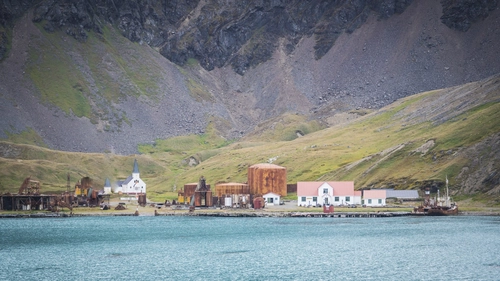
Falkland Islands - South Georgia - Elephant Island - Antarctica - Polar Circle
 23 Days / 22 Nights
23 Days / 22 Nights

Antarctica - Elephant Island - Weddell Sea - Polar Circle
 15 Days / 14 Nights
15 Days / 14 Nights

Antarctica - Polar Circle - Deep South Discovery voyage
 12 Days / 11 Nights
12 Days / 11 Nights

Antarctica - Whale watching discovery and learning voyage
 10 Days / 9 Nights
10 Days / 9 Nights

Antarctica - Beyond the Polar Circle - Wilkins Ice Shelf - Aurora Australis
 16 Days / 15 Nights
16 Days / 15 Nights

Antarctica - Polar Circle - Whale watching
 12 Days / 11 Nights
12 Days / 11 Nights

Falklands, South Georgia and Antarctica - Photographic Special
 21 Days / 20 Nights
21 Days / 20 Nights

Weddell Sea – In search of the Emperor Penguin, incl. helicopters
 11 Days / 10 Nights
11 Days / 10 Nights

Antarctica - Beyond the Polar Circle - whale watching
 12 Days / 11 Nights
12 Days / 11 Nights

Antarctica - Whale watching
 10 Days / 9 Nights
10 Days / 9 Nights

Antarctic Explorer’s Voyage

Wreck Diving in Antarctica

The Research Stations of Antarctica and the sub-Antarctic

The Small but Social Commerson’s Dolphin
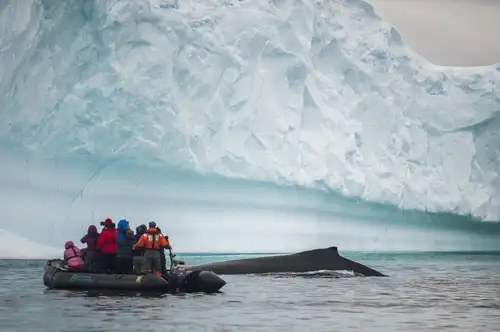
A Day of Whale Watching in Antarctica

15 Fantastic Photos of Antarctica

The Ins, Outs, and Ups of Polar Mountaineering & Ski Mountaineering

Living the Antarctic Dream

Top Antarctica Cruise Experiences for 2025

Of Treacherous Rocks & Audacious Fin Whales

Danger Beneath the Water: 10 Facts About Leopard Seals

Port Lockroy: History, Post Office, and Resident Penguins

Six Facts About the Crabeater Seals of Antarctica

The Eight Great Penguin Species of Antarctica

8 Whales You Might See During Your Antarctica Cruise

Flowers in Antarctica

Weddell Sea, Shackleton’s Endurance, and New Swabia

The Classic Polar Cruise: Antarctic Peninsula Facts, Pics, and More

Camping in Antarctica: a True Expedition Experience








